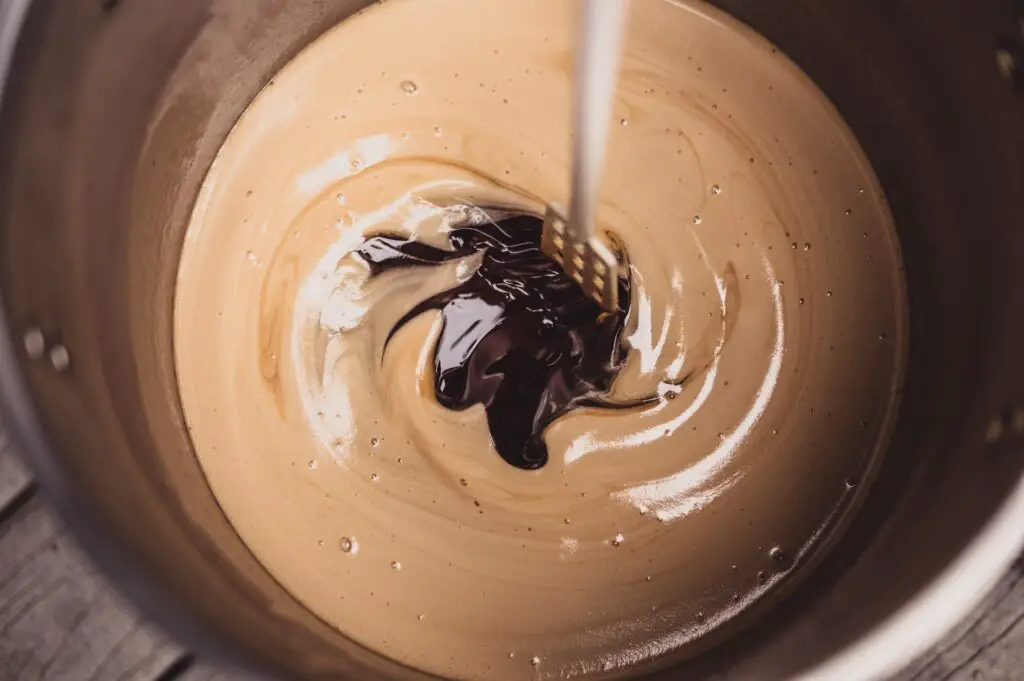If you buy something through a link in our posts, we may get a small share of the sale.
Carbonating your mead is one of the final steps in the brewing process. It is what gives your mead its “sparkle” and makes it effervescent. Therefore, it is essential for every brewer to understand how to carbonate mead so that the final product is perfect and enjoyable to drink.
Contents
How to Carbonate Mead
The best and easiest way to carbonate mead is by adding a little more sugar in the form of honey or dextrose before bottling. This is called “priming” and usually results in a carbonation level of around 2-3 volumes of CO2. The added sugar will feed the yeast, producing CO2 gas. The amount of sugar you add will determine the carbonation level, so it is important to be precise.

Another way to carbonate mead is by force carbonating. This method is often used by commercial brewers and involves using CO2 gas to force carbonate the mead. This is done by pressurizing the fermenter with CO2 and then transferring the mead into bottles or a keg. This method is more difficult and requires special equipment; however, it does allow for more control over the carbonation level.
In most cases, it is best to let the mead ferment out completely before carbonating. This will help to prevent over-carbonation and bottle bombs. However, if you are using the force carbonation method, it is not necessary to let the mead ferment out completely first. The main thing to remember is to be precise with the amount of sugar you add and closely monitor the carbonation level.
Step by Step Instructions
The main goal is to have a fizzy, refreshing, and enjoyable mead. That is why you want to be keen on this process and take your time. The following are the basic steps to carbonate mead and some tips to help you achieve the perfect carbonation level.
Step 1: Prep Your Mead for Carbonation
This is the first and arguably the most important step. You need to make sure your mead is ready to be carbonated. This means ensuring that the mead has fermented out completely and that all sediment has been removed.
If you are using the priming method, it is best to let the mead ferment out completely before carbonating. This will help to prevent over-carbonation and bottle bombs. However, if you are using the force carbonation method, you can carbonate your mead before it has finished fermenting.
To check if your mead has fermented out completely, you will need a hydrometer. Take a reading and ensure that the specific gravity is below 1.010. If it is not, then let the mead ferment for a few more days. Once you have checked that the mead has fermented out completely, remove all sediment so that your mead is nice and clear.
Step 2: Prepare the Bottles
The carbonation will occur in the bottles, so you must ensure they are clean and sanitized. If you have been brewing beer or mead for a while, you probably have some bottles you can reuse. If you are using new bottles, then make sure to clean and sanitize them.
There are various ways to clean and sanitize bottles. One way is to use a no-rinse cleanser. This is a powder or liquid you add to the bottles and then rinse out with hot water. Another way is to use a sanitizing solution. This can be done by submerging the bottles in a sanitizing solution or spraying them with the solution.
You can also boil water and pour it into the bottles. This will kill any bacteria or wild yeast that may be present. Be careful when using this method, as boiling water can crack the bottles.
Step 3: Add the Priming Sugar
Once the mead is ready to be carbonated, and the bottles are clean and sanitized, it is time to add the priming sugar into the bottles. The amount of priming sugar you use will depend on the carbonation level you want to achieve.

For light carbonation, use 3/4 cup of priming sugar per 5 gallons of mead. For medium carbonation, use 1 1/2 cups of priming sugar per 5 gallons of mead. More high carbonation can call for 2 1/4 cups of priming sugar per 5 gallons of mead.
Once you have added the priming sugar, gently stir it into the mead so that it is evenly distributed. Remember that the priming sugar can be any type of sugar, such as honey, corn sugar, or brown sugar. So, don’t worry if you don’t have the exact type of sugar the recipe calls for.
Step 4: Seal up the Bottles
After you have added the priming sugar, it is time to seal up the bottles. If you are using screw-top bottles, make sure they are tightened well. If you are using flip-top bottles, ensure the rubber gasket is in place, and the wire clasp is tightened.
If you don’t seal the bottles correctly, carbonation can escape, and your mead will not be carbonated. Bacteria and wild yeast can also enter the bottles if they are not sealed properly. So, ensure the bottles are sealed tightly, and there are no leaks.
Step 5: Store the Bottles in a Warm Place And Wait for the Carbonation to Occur
Now that the bottles are sealed and primed with sugar, it is time to store them in a warm place so that carbonation can occur. The ideal temperature for carbonation is 70 to 75 degrees Fahrenheit.
At this temperature, the yeast will be active and will consume the sugar, producing carbon dioxide gas. The warmer the temperature, the faster the carbonation will occur. However, if the temperature is too warm, the yeast can become overactive and produce too much carbon dioxide. This can lead to over-carbonation and bottle bombs.
It is at this time that you can monitor the pressure of the bottles. If you are using screw-top bottles, you can do this by gently unscrewing the bottle caps a turn or two and then getting the pressure reading with a pressure gauge. The ideal pressure should be 30PSI. This will give you a carbonation level of 2.5 to 3.0 volumes of CO2.
Step 6: Store the Bottles in a Cool Place
After the carbonation has occurred and the mead is ready for a drink, it is time to store the bottles in a cool place. Ensure the beer is away from light as much as possible. Storing the bottles in a fridge is ideal for keeping the carbonation from escaping and preventing the beer from going bad.

Benefits of Carbonating Mead
Carbonating mead can have several benefits that every mead drinker should know about. Here are some of the benefits:
- Carbonation can help to preserve mead since it prevents oxygen from entering the bottle.
- Carbonation can help improve mead’s flavour by making it smoother and more refreshing.
- It helps extend mead’s shelf life since it prevents spoilage.
- It can help to make it less likely to cause a hangover since carbonation can speed up the metabolism of alcohol.
Frequently Asked Questions
How Do You Get Carbonation in Mead?
To get carbonation in mead, you need to add a priming sugar before bottling. The sugar will feed the yeast, and the yeast will produce carbon dioxide gas. The gas will dissolve into the mead and carbonate it.
Can You Force Carbonate Mead?
Yes, you can force carbonate mead using a carbonation stone or adding carbon dioxide gas directly to the mead. However, you should be very careful when forcing carbonating mead since too much carbon dioxide can make the mead taste harsh and bubbly.
Conclusion
A carbonated mead means a smoother and more refreshing drink. It is the dream of every mead lover to have a well-carbonated mead with just the right amount of fizz. If you put more effort and time into carbonating your mead, you will be rewarded with a delicious and refreshing.

